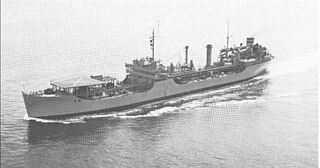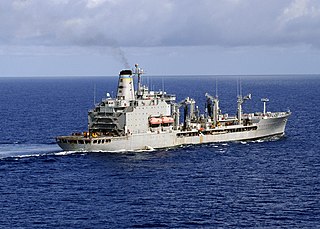This page is based on this
Wikipedia article Text is available under the
CC BY-SA 4.0 license; additional terms may apply.
Images, videos and audio are available under their respective licenses.
Four United States Navy ships, including one rigid airship, and one ship of the Confederate States of America, have been named Shenandoah, after the Shenandoah River of western Virginia and West Virginia.
USS Potomac or USNS Potomac may refer to one of these United States Navy ships:

SS Mission Capistrano was a Type T2-SE-A2 tanker built for the United States Maritime Commission during World War II. After the war she was acquired by the United States Navy as USS Mission Capistrano (AO-112). Later the tanker transferred to the Military Sea Transportation Service as USNS Mission Capistrano (T-AO-112). She was a Mission Buenaventura-class oiler and was named for San Juan Capistrano in San Juan Capistrano, California.

SS Mission Buenaventura was a Type T2-SE-A2 tanker built for the United States Maritime Commission during World War II. After the war she was acquired by the United States Navy as USS Mission Buenaventura (AO-111). Later the tanker transferred to the Military Sea Transportation Service as USNS Mission Buenaventura (T-AO-111). The lead ship in her class of fleet oilers, she was named for Mission San Buenaventura located in Ventura, California.

SS Mission Dolores was a Mission Buenaventura-class oiler built for the United States Maritime Commission during World War II, named for Mission San Francisco de Asís in San Juan Capistrano, California, one of two named for the Franciscan mission located in San Francisco, California.

USNS Mission Los Angeles (T-AO-117) was a Mission Buenaventura-class oiler that served in the United States Navy. The ship was originally intended as USS Conecuh (AO-103) for the U.S. Navy but her acquisition was canceled. The ship, a Type T2-SE-A3 tanker, was completed as SS Mission Los Angeles and delivered after the end of World War II. The tanker was acquired by the U.S. Navy in 1948 as USS Mission Los Angeles (AO-117), but was transferred to the Military Sea Transport Service upon its creation in 1949. The ship was named for Nuestra Señora Reina de los Angeles Asistencia, she was the only U.S. Naval Vessel to bear the name.

SS Mission San Fernando was a Type T2-SE-A2 tanker built for the United States Maritime Commission during World War II. After the war she was acquired by the United States Navy as USS Mission San Fernando (AO-122). Later the tanker transferred to the Military Sea Transportation Service as USNS Mission San Fernando (T-AO-122). She was a member of the Mission Buenaventura-class oiler and was named for Mission San Fernando Rey de España in Los Angeles. She was later renamed USNS Muscle Shoals (T-AGM-19), and, later, USNS Vanguard (T-AG-194).
SS Mission San Luis Rey was a Type T2-SE-A2 tanker built for the United States Maritime Commission during World War II. After the war she was acquired by the United States Navy as USS Mission San Luis Rey (AO-128). Later the tanker transferred to the Military Sea Transportation Service as USNS Mission San Luis Rey (T-AO-128). She was a Mission Buenaventura-class oiler and was named for Mission San Luis Rey de Francia, located in Oceanside, California.

SS Mission San Rafael was a Type T2-SE-A2 tanker built for the United States Maritime Commission during World War II. After the war she was acquired by the United States Navy as USS Mission San Rafael (AO-130). Later the tanker transferred to the Military Sea Transportation Service as USNS Mission San Rafael (T-AO-130). She was a member of the Mission Buenaventura-class oiler and was named for Mission San Rafael Arcángel, she was the only U.S. Naval vessel to bear the name.

SS Mission Solano was a Type T2-SE-A2 tanker built for the United States Maritime Commission during World War II. After the war she was acquired by the United States Navy as USS Mission Solano (AO-135). Later the tanker transferred to the Military Sea Transportation Service as USNS Mission Solano (T-AO-135). A Mission Buenaventura-class oiler, she was named for Mission San Francisco Solano, she was the only U.S. Naval vessel to bear the name.

USNS John Lenthall (T-AO-189) is a Henry J. Kaiser-class fleet replenishment oiler of the United States Navy. Her motto is "Shaft of the Spear."

USNS Big Horn (T-AO-198) is a Henry J. Kaiser-class fleet replenishment oiler of the United States Navy.

USNS Laramie (T-AO-203) is a Henry J. Kaiser-class underway replenishment oiler operated by the Military Sealift Command to support ships of the United States Navy.

USNS Maumee (T-AO-149), later T-AOT-149, was a United States Navy Maumee-class oiler, later transport oiler, in non-commissioned service with the Military Sea Transportation Service (MSTS), later Military Sealift Command, from 1956 until probably the mid-1980s.

USNS Shoshone (T-AO-151), later T-AO-151T, was a United States Navy Maumee-class oiler, later transport oiler, in non-commissioned service with the Military Sea Transportation Service (MSTS), later Military Sealift Command, from 1957 until probably the mid-1980s.

The Maumee class was a class of four United States Navy fleet oilers in service from the mid-1950s until the mid-1980s. It was the first class of United States Naval Ships.
The Naval Fleet Auxiliary Force is a division of the US Navy. The 42 ships of the Military Sealift Command's Naval Fleet Auxiliary Force are the supply lines to U.S. Navy ships at sea. These ships provide virtually everything that Navy ships need, including fuel, food, ordnance, spare parts, mail and other supplies. NFAF ships enable the Navy fleet to remain at sea, on station and combat ready for extended periods of time. NFAF ships also conduct towing, rescue and salvage operations or serve as floating medical facilities. All NFAF ships are government owned and crewed by civil service mariners. Some of the ships also have a small contingent of Navy personnel aboard for operations support, supply coordination and helicopter operations.












